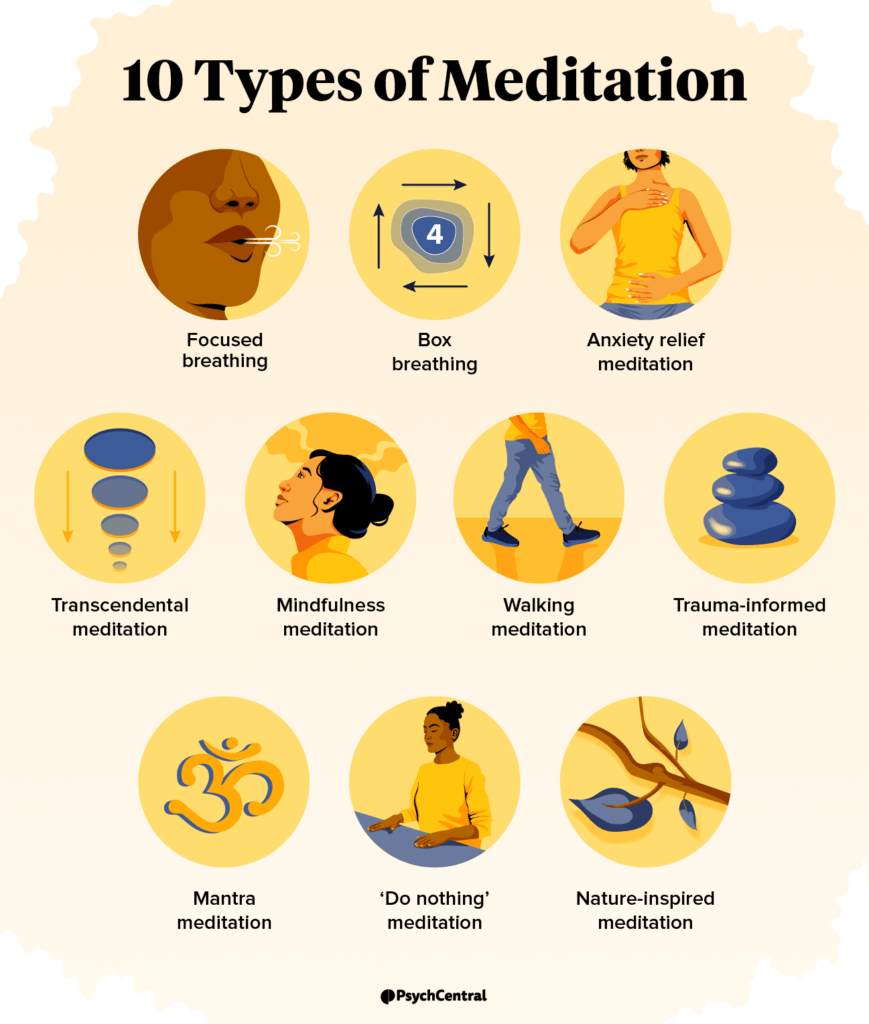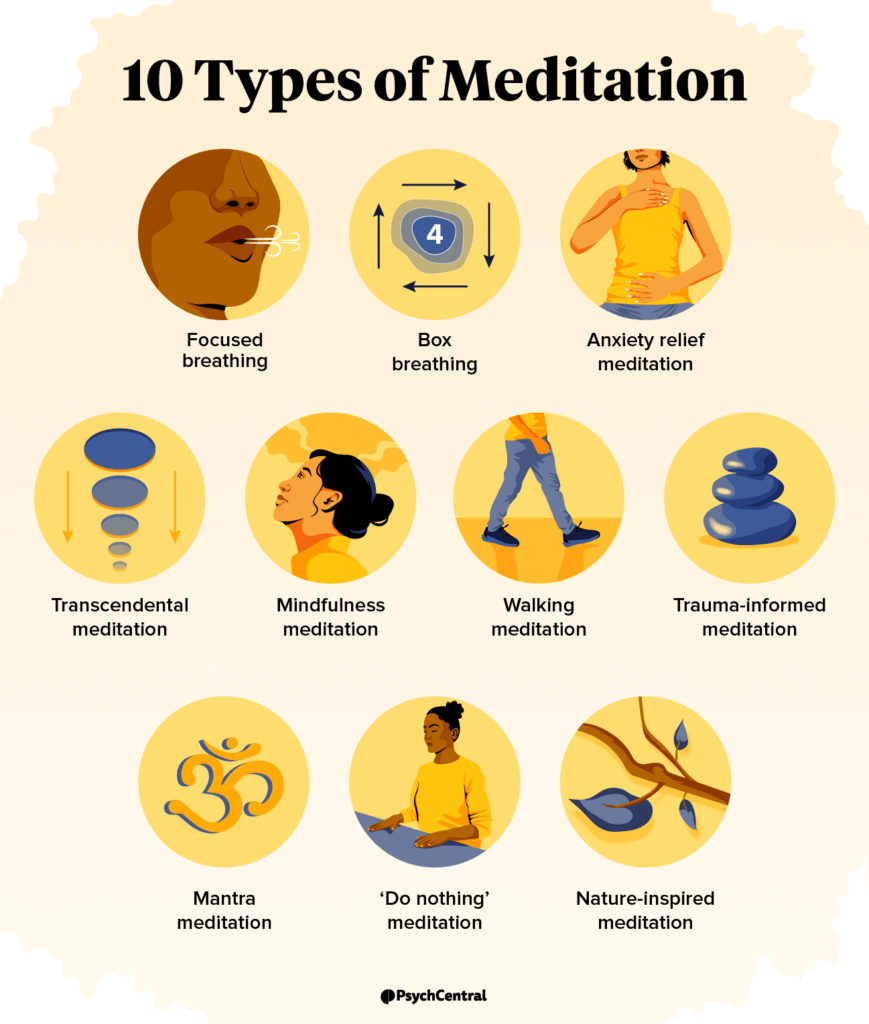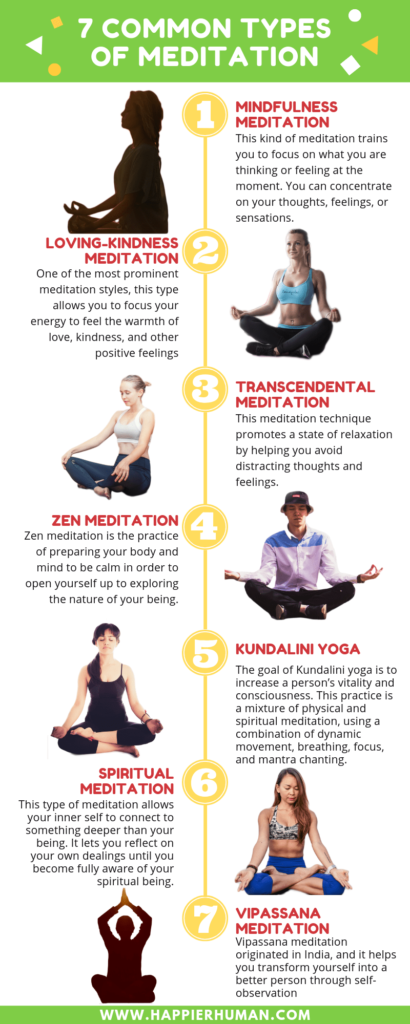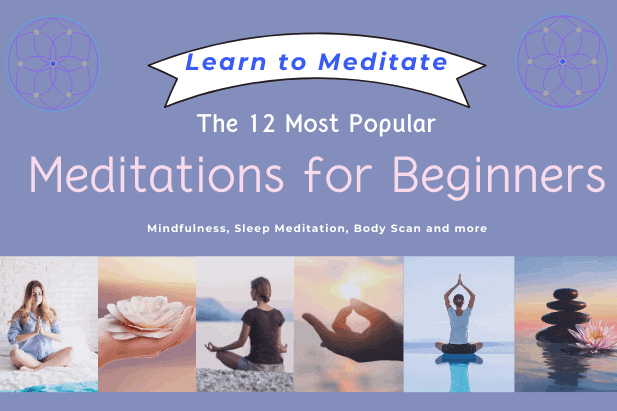
Are you interested in developing awareness and improving your well-being? If so, you may be curious about different types of meditation. Meditation is a technique that can help you become more aware of the present moment, and it has both physical and psychological benefits, such as reducing stress and boosting immunity. In this article, you’ll learn about nine popular types of meditation, including mindfulness, spiritual, focused, movement, mantra, transcendental, progressive relaxation, loving-kindness, and visualization meditation. Each type of meditation requires different skills and mindsets, so it’s important to find a practice that feels comfortable and encourages regular practice. By incorporating meditation into your routine, you may experience lower blood pressure, reduced stress, improved sleep, better emotional regulation, increased focus, enhanced mood, and greater adaptability. It may also be beneficial for specific conditions like depression, anxiety disorders, cardiovascular disease, dementia, Parkinson’s disease, insomnia, and chronic pain. If you’re interested in exploring different meditation practices, there are plenty of online options available to help you get started. Being open to trying different forms of meditation is key to finding the one that works best for you.

Mindfulness Meditation
Definition and Purpose
Mindfulness meditation is a popular form of meditation that involves bringing one’s attention to the present moment. The purpose of mindfulness meditation is to develop awareness and acceptance of one’s thoughts, feelings, and sensations without judgment. By practicing mindfulness, you can learn to observe your thoughts and emotions without becoming attached to them, which can lead to a sense of calm and mental clarity.
Techniques and Practices
There are several techniques and practices involved in mindfulness meditation. One common practice involves focusing on the breath. You can sit or lie down in a comfortable position and simply observe your breath as it goes in and out. As you do this, you may notice your mind wandering, and that’s okay. The goal is to gently bring your attention back to the breath whenever you become aware that your mind has wandered.
Another technique used in mindfulness meditation is body scanning. This involves bringing your attention to different parts of your body, starting from the top of your head and moving down to your feet. As you bring your awareness to each body part, you can notice any sensations or discomfort and simply observe them without judgment or the need to change them.
Benefits and Effects
Mindfulness meditation has been extensively studied and has been shown to have numerous benefits for both physical and mental health. In terms of physical health, mindfulness meditation has been found to lower blood pressure, reduce symptoms of chronic pain, and boost the immune system. It has also been shown to improve sleep quality and increase overall well-being.
In terms of mental health, mindfulness meditation has been found to reduce stress and anxiety, improve emotional regulation, and increase attention and focus. It has also been shown to improve mood and decrease symptoms of depression. Additionally, mindfulness meditation has been found to promote greater adaptability and resilience in the face of stress and adversity.
Overall, mindfulness meditation is a powerful practice that can improve both physical and mental well-being. By cultivating a sense of awareness and acceptance, you can learn to navigate life’s challenges with greater ease and find a sense of peace and contentment in the present moment.
Spiritual Meditation
Exploring the Divine
Spiritual meditation is a practice that focuses on connecting with something greater than oneself. It is often a way to explore one’s spirituality and deepen one’s connection with a higher power, the divine, or a universal energy. Spiritual meditation can be practiced within the framework of a specific religion or can be more open-ended and encompass a broader sense of spirituality.
Connecting to Higher Power
One of the main goals of spiritual meditation is to connect with a higher power or divine presence. This connection can provide a sense of comfort, guidance, and support in times of difficulty and uncertainty. Spiritual meditation often involves praying, chanting, or reciting sacred texts or mantras to facilitate this connection.
Deepening Spiritual Awareness
Spiritual meditation also aims to deepen one’s spiritual awareness and understanding. Through regular practice, individuals can develop a greater sense of self-awareness, discernment, and insight into their own spiritual path. This can lead to a more profound understanding of their purpose in life and their connection to the world around them.
Focused Meditation
Attentive Concentration
Focused meditation is a type of meditation that involves concentrating on a specific object or focal point. This can be anything from a candle flame, a sound, a word or phrase, or even one’s own breath. The goal of focused meditation is to cultivate a state of single-pointed focus and attention.
Practicing Single-pointed Focus
To practice focused meditation, find a quiet and comfortable place to sit or lie down. Choose an object of focus, such as a candle flame, and place it at eye level. Gently gaze at the flame, allowing your attention to rest solely on it. As you do this, you may notice thoughts or distractions arise. Simply acknowledge them and gently bring your attention back to the flame.
Improving Attention Span
Focused meditation is a powerful tool for improving attention span and concentration. By regularly practicing single-pointed focus, you can train your mind to stay present and fully engaged in the task at hand. This can be particularly beneficial in today’s fast-paced world, where distractions are abundant and the ability to maintain focus is often compromised.
Movement Meditation
Incorporating Physical Movements
Movement meditation is a type of meditation that involves incorporating physical movements into the practice. This can include gentle yoga postures, walking meditation, tai chi, or even dancing. The purpose of movement meditation is to bring the mind and body into a state of harmony and unity.
Combining Mindfulness and Body Motion
During movement meditation, the focus is on bringing mindfulness to each movement and sensation that arises in the body. By consciously moving and paying attention to the physical sensations, individuals can cultivate a deep sense of presence and embodiment. This can help to release tension, promote relaxation, and enhance the mind-body connection.
Enhancing Mind-Body Connection
One of the main benefits of movement meditation is the enhancement of the mind-body connection. By practicing mindful movement, individuals can become more attuned to the subtle signals and messages that their body is sending them. This increased awareness can help to prevent injuries, improve physical coordination, and promote overall well-being.

Mantra Meditation
Repetition of Sacred Sounds or Phrases
Mantra meditation is a type of meditation that involves the repetition of sacred sounds or phrases. A mantra can be a word or a group of words that holds spiritual significance to the individual. The repetition of the mantra serves as a focal point for the mind, helping to quiet the thoughts and cultivate a sense of inner peace.
Creating Harmonious Vibrations
The repetition of the mantra creates vibrational energy that can have a powerful effect on the mind and body. As the mantra is repeated, the sound waves resonate within the body, creating a sense of harmony and balance. This can help to calm the mind, reduce stress, and promote a sense of deep relaxation.
Cultivating Inner Peace and Clarity
Mantra meditation is often used as a tool for cultivating inner peace and clarity. By focusing on the mantra and letting go of other thoughts, individuals can experience a state of deep relaxation and stillness. This can help to quiet the mind, reduce mental chatter, and create a sense of spaciousness and clarity within.
Transcendental Meditation
Using a Personalized Mantra
Transcendental meditation is a specific technique that involves the use of a personalized mantra. The mantra is given to the individual by a trained teacher and is used as a focal point for the meditation. By repeating the mantra silently, individuals can access deeper levels of consciousness and experience a state of transcendence or bliss.
Accessing Deep Silent Levels of Consciousness
Transcendental meditation is often described as a form of effortless meditation, as it involves allowing the mind to settle into a state of deep silence and stillness. By regularly practicing transcendental meditation, individuals can access deeper levels of consciousness and experience a sense of expanded awareness.
Promoting Relaxation and Stress Reduction
One of the key benefits of transcendental meditation is its ability to promote relaxation and reduce stress. By quieting the mind and accessing a state of deep rest, individuals can experience a release of stress and tension. This can have a profound effect on overall well-being and can help to improve physical and mental health.

Progressive Relaxation Meditation
Relaxing and Releasing Muscle Tension
Progressive relaxation meditation is a practice that involves systematically relaxing and releasing tension in the muscles of the body. This can be particularly beneficial for individuals who carry a lot of physical tension or who experience chronic pain. By consciously relaxing the muscles, individuals can promote a sense of deep relaxation and physical ease.
Systematically Scanning and Loosening the Body
To practice progressive relaxation meditation, find a quiet and comfortable place to sit or lie down. Begin by bringing your attention to your toes and consciously relax them. Move your attention slowly up through the body, releasing tension in each muscle group as you go. The key is to bring awareness to each area of the body and consciously let go of any tension or tightness.
Easing Physical and Mental Stress
Progressive relaxation meditation is a powerful tool for easing physical and mental stress. By consciously relaxing the muscles, individuals can release built-up tension and promote a sense of physical ease. This can have a cascade effect on the mind, helping to calm racing thoughts and promote a sense of tranquility and well-being.
Loving-Kindness Meditation
Cultivating Compassion and Kindness
Loving-kindness meditation is a practice that involves cultivating feelings of compassion, love, and kindness towards oneself and others. It is often used as a tool for developing empathy and fostering positive relationships. Loving-kindness meditation involves sending well-wishes or blessings to oneself and others, including loved ones, neutral individuals, and even challenging people in one’s life.
Sending Well-wishes to Self and Others
To practice loving-kindness meditation, find a quiet place to sit or lie down. Start by focusing on yourself and silently repeat phrases such as “May I be happy, may I be healthy, may I be safe, may I live with ease.” After a few minutes, expand your focus to include a loved one, then a neutral person, and finally a challenging person. Repeat the phrases for each individual, sending them well-wishes and blessings.
Fostering Positive Emotions and Relationships
Loving-kindness meditation is a powerful tool for fostering positive emotions and cultivating deeper connections with others. By regularly practicing loving-kindness meditation, individuals can develop a greater sense of empathy, compassion, and kindness. This can have a profound effect on relationships, helping to foster harmonious interactions and deepening connections with others.

Visualization Meditation
Creating and Imagining Peaceful Scenes
Visualization meditation is a practice that involves creating and imagining peaceful scenes or visualizations in the mind’s eye. By bringing these scenes to life in the imagination, individuals can tap into the power of visualization and harness its potential for healing and transformation. Visualization meditation is often used as a tool for manifesting desires and goals.
Engaging the Senses and Imagination
To practice visualization meditation, find a quiet and comfortable place to sit or lie down. Close your eyes and bring to mind a peaceful scene or visualization. Engage all your senses and imagine the scene in vivid detail. For example, if you are visualizing a beach, imagine the feel of the warm sand beneath your feet, the sound of the waves crashing against the shore, and the salty smell of the ocean air.
Harnessing the Power of Visualization
Visualization meditation is a powerful tool for harnessing the power of the mind and the imagination. By visualizing positive scenes and experiences, individuals can create a blueprint for what they want to manifest in their lives. This can help to increase motivation, boost confidence, and bring about positive changes in various areas of life.
Conclusion
Finding Your Perfect Meditation Practice
With so many different types of meditation available, it’s important to find the practice that feels most comfortable and resonates with you. Take the time to explore different forms of meditation and see which ones resonate with your interests and goals. You may find that you enjoy the sense of calm and clarity that comes with mindfulness meditation, or you may be drawn to the deep spiritual connection that comes with spiritual meditation. Whatever practice you choose, remember that consistency is key. Regular practice is essential for experiencing the full benefits of meditation.
Embracing the Benefits of Mindfulness
Regardless of the type of meditation you choose, one thing is certain – mindfulness is a powerful tool for developing awareness and improving overall well-being. By bringing your attention to the present moment, you can cultivate a sense of presence, peace, and acceptance. Mindfulness can help you navigate the ups and downs of life with greater ease and grace.
Continuing to Explore and Evolve
As you continue your meditation journey, be open to exploring new techniques and approaches. The field of meditation is vast and ever-evolving, with new practices constantly emerging. Stay curious and open-minded, and don’t be afraid to step outside of your comfort zone. The more you explore and experiment, the more you will deepen your practice and unlock new levels of awareness and growth.
Remember, meditation is a personal journey. What works for one person may not work for another. Trust your intuition and listen to what feels right for you. With dedication, practice, and an open heart, you can harness the power of meditation to transform your life and cultivate a deeper sense of awareness and peace.
